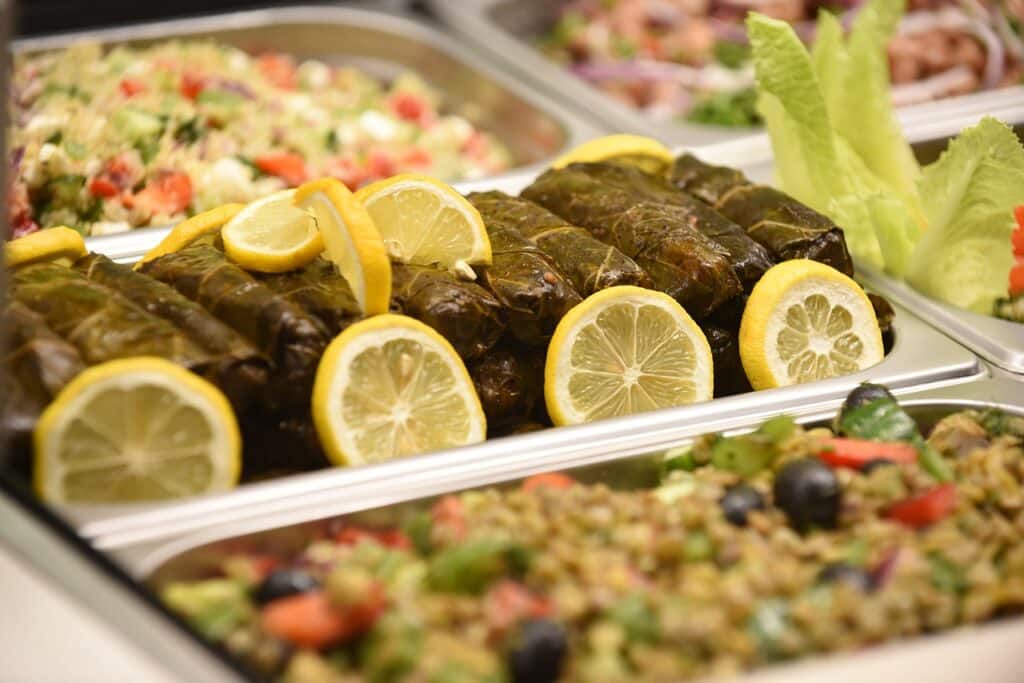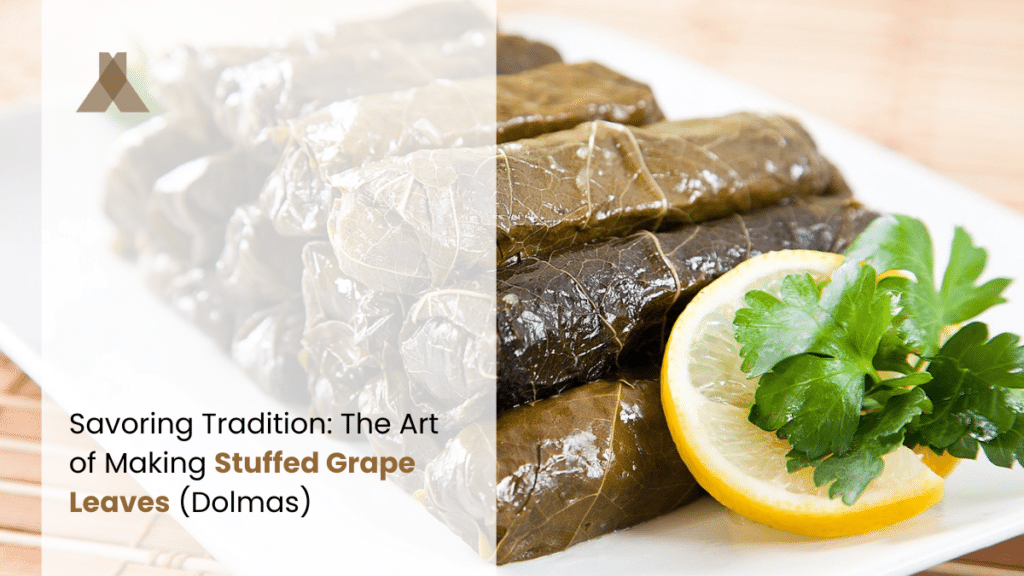Stuffed grape leaves, often called dolmas or dolmades, are a real treat from the Mediterranean and Middle Eastern culinary worlds. These little parcels are packed with rice, herbs, and sometimes meat, all snugly wrapped in grape leaves. They’re a go-to for big family meals and joyful celebrations, showing up in different styles from Greece to Turkey to Iran and beyond.
Each place adds its own spin, making dolmas a cool glimpse into how food adapts and thrives across different cultures. In the Mediterranean, you might enjoy them cold, drizzled with olive oil and a squeeze of lemon—perfect for a refreshing snack. Over in the Middle East, they’re often served warm, soaked in a tangy tomato sauce that really brings out the flavors.
Chatting about stuffed grape leaves isn’t just food talk—it’s like opening a culinary diary that spans centuries. They’re more than just tasty; they’re a piece of cultural heritage that ties today’s feasts back to ancient traditions. Isn’t it amazing how a simple dish can tell such a rich story? Let’s dive into this tradition and maybe even roll a few dolmas ourselves.

The Origins and Cultural Significance of Dolmas
Dolmas have a storied past that spans several ancient civilizations. Some culinary historians suggest that the origins of stuffed grape leaves could be traced back to the era of Alexander the Great, who introduced the Middle Eastern practice of stuffing vegetables to the Greeks. From there, the dish spread across the empire, evolving with each region’s local ingredients and culinary traditions.
Regional variations
As dolmas traveled, they adopted different identities. In Turkey, you’ll find them often meat-packed and served warm as part of a main course. Greek versions, known as dolmades, are typically vegetarian and served cold or at room temperature, often with a side of thick, creamy tzatziki. Moving towards the Eastern Mediterranean and the Arab world, dolmas may include a tangy touch of pomegranate molasses or a sprinkle of sumac, adding a unique, sour kick that brightens the hearty dish.
Cultural Dish
In every region, dolmas carry more than just flavor; they carry a piece of cultural identity. Often prepared for large gatherings and special occasions, making dolmas is a communal activity where family members come together to share stories and pass down culinary techniques from one generation to the next. This tradition reinforces the role of food as a means to preserve culture and maintain a connection to history and heritage.
Exploring the history and variations of dolmas not only enriches our understanding of this culinary delight but also illustrates how food can bridge cultures, celebrating both diversity and commonality across the table.
Key Ingredients and Preparations
When it comes to whipping up some delicious dolmas, knowing the right ingredients and preparation steps is key. Here’s a breakdown of the essentials you’ll need and how to get started:
Essential Ingredients
The heart of any dolma dish starts with the grape leaves themselves. You can find these preserved in brine at most international or specialty food stores. Next up are the fillings, which typically include:
- Rice: This forms the base of your filling, soaking up all the flavors you add to it.
- Herbs: Fresh dill, parsley, and mint are popular choices that give dolmas their distinctive, vibrant taste.
- Onions and garlic: These are sautéed until soft and mixed into the rice for depth of flavor.
- Nuts and currants: For a bit of texture and sweetness, chopped pine nuts and currants or raisins are often included.
- Spices: A pinch of cinnamon, allspice, and black pepper can elevate the filling to new heights.
Preparation Guide
Now that you’ve got your dolmas ingredients ready, let’s walk through the basic steps to prepare these stuffed grape leaves:
- Prepare the grape leaves: Rinse the leaves in cold water to remove excess brine and soften them up. Trim any tough stems that might make rolling difficult.
- Make the filling: Cook the onions and garlic until they’re soft. Add the rice, herbs, spices, nuts, and currants, cooking until the rice is just starting to soften but isn’t fully cooked. This mixture will cook further when wrapped in the leaves.
- Wrap the leaves: Place a spoonful of filling near the stem end of a leaf. Fold in the sides and roll the leaf up tightly, like a small cigar. The key here is to ensure the filling is snug, but not too tight as the rice will expand a bit more.
- Cook the dolmas: Arrange the stuffed leaves in a pot, packing them closely so they don’t unravel during cooking. Pour over a mixture of water, olive oil, and lemon juice, then simmer gently until the rice is fully cooked.
With these steps, you’re well on your way to creating authentic, flavorful dolmas at home.
Whether you stick strictly to tradition or add your own twist, the process of making dolmas is as rewarding as enjoying them!
Cooking Techniques: From Filling to Serving
Traditional methods of preparing dolmas begin with the art of wrapping—neatly folding the grape leaves around the filling to ensure they hold their shape during cooking.
Serving stuffed grape leaves is all about presentation and pairing:
- With yogurt or tzatziki: The coolness of yogurt or tzatziki complements the spices of the dolmas, balancing the flavors.
- Alongside other dishes: Serve them as part of a mezze platter with other
- Mediterranean favorites like hummus, tabbouleh, and olives.
- Garnishes: A sprinkle of fresh herbs or a drizzle of olive oil can enhance their visual appeal and add a fresh flavor kick.
Variations and Modern Twists
Modern chefs have infused dolmas with a variety of global influences, incorporating ingredients like quinoa or couscous instead of the traditional rice, or adding spices like curry or chipotle for an unexpected flavor profile. These innovations not only refresh the dish but also connect different culinary traditions, showing the versatility of dolmas in global cuisine.
Vegetarian and meat variants
Traditionally, dolmas could be found in both vegetarian and meat-containing versions, but contemporary variations take this further. Vegetarian dolmas might include a rich blend of chopped nuts, dried fruits, and aromatic herbs, offering a satisfying texture and flavor. Meat variants, on the other hand, often feature ground lamb or beef, seasoned with regional spices, providing a hearty and filling version of the classic recipe.
These adaptations of dolmas, whether they lean towards modern recipes or stick with vegetarian or meat-based fillings, showcase the dish’s ability to evolve while still retaining its cultural essence. This adaptability not only keeps the tradition alive but also makes it accessible and enjoyable for new generations and diverse cultures.
Health Benefits of Dolmas
Diving into the health benefits of dolmas reveals why this dish is not just a cultural staple but also a nutritious choice for various dietary preferences.
Health benefits of dolmas
Dolmas are packed with ingredients that offer substantial nutritional benefits. The grape leaves used as the wrapping are rich in vitamins A, C, and E, as well as iron and antioxidants, which help boost the immune system and promote healthy skin. The filling, usually a mix of rice and herbs, provides a good source of fiber, especially when whole-grain rice is used.
Nutritional information
Beyond the basic vitamins and minerals, dolmas can be enriched with pine nuts or walnuts, adding healthy fats and proteins to the mix. When meat is included, it increases the protein content, making dolmas a more filling option. The addition of herbs like dill and mint not only enhances flavor but also contributes additional nutrients, such as vitamin K and iron.
Dietary considerations
Dolmas are incredibly versatile and can fit into various dietary regimes. For those on vegetarian or vegan diets, dolmas can be prepared without meat, focusing on the rich flavors of the herbs and spices. For low-carb or ketogenic diets, the rice can be substituted with cauliflower rice, making it suitable without sacrificing texture or taste. Additionally, the ingredients in dolmas are naturally gluten-free, making them a safe option for those with gluten sensitivities.
Conclusion
In wrapping up our exploration of stuffed grape leaves, it’s clear that dolmas are much more than just a dish; they are a celebration of culinary tradition that has stood the test of time. From their ancient origins to their modern-day variations, dolmas continue to be a beloved staple in kitchens across the Mediterranean and Middle East.
These little rolls, packed with flavor and history, offer a delightful insight into the regions’ rich culinary landscapes. Whether served warm with a tangy tomato sauce or cold with a refreshing splash of lemon, dolmas have a unique way of bringing people together, offering a taste of tradition with every bite.
We encourage you to try making dolmas at home. It’s a wonderful way to dive into a rich culinary tradition and create something delicious and authentic in your own kitchen. Preparing homemade recipes like dolmas can be a delightful journey through history and culture, providing a hands-on connection to far-off places and past times. So, gather your ingredients, invite some friends or family over, and enjoy the art of making and sharing dolmas. It’s not just about cooking; it’s about creating memories around the table.



